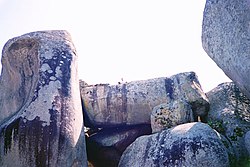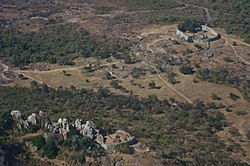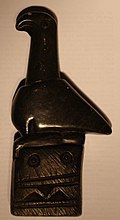Great Zimbabwe
Great Zimbabwe is a ruined city in the southeastern hills of Zimbabwe. It was a royal city for the Zimbabwean monarch. It was also the capital of the Kingdom of Zimbabwe during the country’s later Iron Age.
| Location | Masvingo Province, Zimbabwe |
|---|---|
| Coordinates | 20°16′S 30°56′E / 20.267°S 30.933°ECoordinates: 20°16′S 30°56′E / 20.267°S 30.933°E |
| Type | Settlement |
| Part of | Kingdom of Zimbabwe |
| Area | 7.22 square kilometres (1,780 acres) |
| History | |
| Founded | 11th century |
| Abandoned | 15th century |
| Periods | Late Iron Age |
| Cultures | Kingdom of Zimbabwe |
| Site notes | |
| Official name | Great Zimbabwe National Monument |
| Criteria | Cultural: i, iii, vi |
| Reference | 364 |
| Inscription | 1986 (10th Session) |
The site is not far from the country's border with Mozambique, which is in the southeast of the African continent.
History
The earliest known written mention of the ruins was in 1531 by Vicente Pegado, Captain of the Portuguese garrison of Sofala, who recorded it as Symbaoe.
After visiting the area for the first time in the late 19th century, Europeans began Investigations of the site in 1871.[1]
The modern country of Zimbabwe is named after Great Zimbabwe.
Features
Construction on the monument began in the 11th century, and work continued until the 14th century.
Once built, the city covered an area of 722 hectares (1,780 acres) which might have housed up to 18,000 people. Its walls were one of its most prominent features; these were constructed without mortar, and some were over five metres high. Eventually the city was abandoned and fell into ruin.
The Kingdom of Zimbabwe included the River Zambezi in the north, the Transvaal in the south and Botswana in the east. The people who lived at Great Zimbabwe controlled trade between the coast and inland Africa.
Artifacts
Archaeologists have found goods from as far as China that were used by the Great Zimbabwean people. This shows that they bought and sold things over great distances.
The city had stopped growing when traders from Portugal came to southern Africa 500 years ago, but nobody is sure why this happened. Europeans at first thought that Great Zimbabwe had been built by foreigners. Now we know it was built by the local people.
People who have studied the site have learned much about old Africa.
Great Zimbabwe Media
Overview of Great Zimbabwe. The large walled construction is the Great Enclosure. Some remains of the valley complex can be seen in front of it.
View west from the Eastern Enclosure of the Hill Complex, showing the granite boulder that resembles the Zimbabwe Bird and the balcony.
Great Zimbabwe appears on Abraham Ortelius' 1570 map Africae Tabula Nova, rendered "Simbaoe".
References
- ↑ Fleminger, David (2008). Mapungubwe Cultural Landscape. 30 Degrees South. p. 57. ISBN 978-0-9584891-5-7.
![]()








